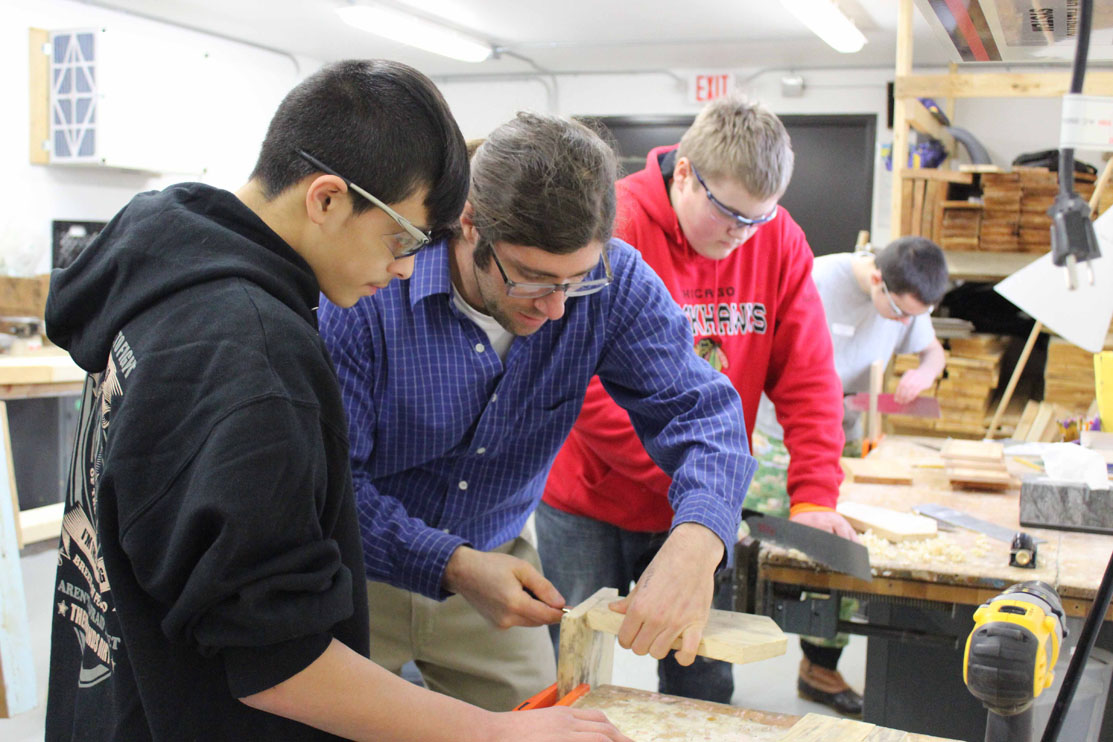After years of planning, the sound of saws and smell of wood fill one of three modular classrooms at Chapman School.
Wearing safety glasses, students check and double check directions on sheets of paper and computerized diagrams. They make sure their measurements are correct, their cuts exact. Teacher Jonathan Sharp moves from workstation to workstation, answering questions, offering suggestions and lending a helping hand. Little by little, one piece of wood attached to another piece of wood, bird feeders begin to take shape.
“There’s a lot of conceptual stuff on computers, which is also fun, but kids need that tactile cutting and sawing, measuring and constructing, and there’s a lot of body movement,” said Sharp of giving students opportunities to move around the classroom, to learn the importance of body position when you wield a hammer or use a saw. “And it also is just fun.”
Before coming to Chapman, Sharp taught high school, including shop classes, for three years at New Stuyahok. After arriving at the Anchor Point preK-8, Sharp worked with Principal Conrad Woodhead to get the shop program organized and available for students who may continue on to Homer High School and HHS teacher Cam Wyatt’s construction class. Sharp is familiar with Wyatt’s class and is organizing Chapman’s program around what is offered at the high school level.
“It gives kids the exposure and experience with power tools, hand tools and safety procedures so when they go to high school, they’ll have that background knowledge and be more successful,” said Sharp.
The Chapman shop class is offered to boys and girls in grades five through eight, with each grade meeting a half hour once a week. Tools and materials stand at the ready when students walk in the door, with students paying a fee of $5-$6 to keep their completed birdhouse or feeder, or the item will be used in a raffle “and the profit goes back into the program,” said Sharp.
As the math and science teacher for grades 5-8 at Chapman, Sharp ties the shop projects into the math and science curriculum. For instance, the Alaska Department of Fish and Game post species-specific birdhouse information online. It lists species of birds by region of the state; where birdhouses should be placed depending on habitat used; size of birdhouses and their entrance; whether the entrance should be round, square, rectangular or an ellipse; and where entrances should be placed in relationship to the roof. Consideration also is given to keeping out unwanted species, the addition of nest ledges and times of year the birdhouse will be used. For instance, woodpecker nest boxes should be six to 20 feet above the ground; open places are best for swallows; chickadees, owls and woodpeckers are some of Alaska’s winter birds.
Using hand tools, the fifth- and sixth-graders are constructing birdhouses, while the seventh- and eighth-graders are using power tools to create birdfeeders. Stacks of lumber, tools and workbenches are arranged to maximize the space inside the portable classroom.
“We have a lot of hand tools and a lot of bench-top stuff and a fairly small space, so when we have eight students in there, it fills up fast,” said Woodhead. “We wanted to make sure there was enough space to produce product.”
Larger class projects, such as planters and a picnic table, are planned for later this year, and also will be auctioned off to help the program be self-supporting.
WIth the cost of materials high and an annual shop budget of less than $1,000, Sharp would welcome donations.
“I don’t even care if it’s lightly used or reclaimed. That’s fine. Just nothing rotten. And I don’t mind pulling a few nails,” he said.
Also welcomed would be construction demonstrations.
“If a local business is interested in coming by, or a construction or heavy equipment business and doing a demonstration for the kids, even a field trip, that would be great,” said Sharp. “I’m open to ideas.”
McKibben Jackinsky can be reached at mckibben.jackinsky@homernews.com.


